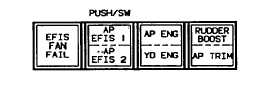TM 1-1510-224-10
e.
Annunciator System General. In the frontal
view, the annunciator panels present rows of small
opaque rectangular annunciators. Word printing on the
respective indicator identifies the monitored function,
situation, or fault condition, but it cannot be read until the
annunciator is illuminated. Blank annunciators (no word
printing) are non-functioning annunciators. The bulbs of
all annunciator panels are tested by activating the
ANNUNCIATOR TEST switch, located on the copilot's
subpanel near the caution/advisory panel. The system
is protected by the 5-ampere circuit breakers placarded
ANN PWR and ANN IND on the overhead circuit
breaker panel (fig. 2-9). The annunciators are dimmed
when the MASTER light switch is ON and the pilot's
flight instrument lights are illuminated. The annunciators
are automatically reset to maximum brightness if:
(1)
Both generators are not producing power
(or turned OFF) with MASTER SWITCH ON.
(2)
The INSTRUMENT PANEL light switch is
rotated clockwise.
(3)
The MASTER light switch is off.
(4)
The MASTER light switch is ON and the
PILOT INSTRUMENTS light switch is OFF.
NOTE
AP EFIS 1 AND AP EFIS 2 IS A
PUSHBUTTON SWITCH ON PILOT'S
SIDE ONLY.
AP015464 C
Figure 2-43. Autopilot/EFIS/Rudder Boost Remote
Annunciator Panel
f.
Master Warning Annunciators (red).
Two MASTER WARNING annunciators, one located on
each side of the glareshield (fig. 2-18), are provided to
alert the crew of a hazardous condition. Any time a
warning annunciator illuminates, the MASTER
WARNING annunciator will flash, and will remain
flashing until the MASTER WARNING annunciator is
reset. If a new condition occurs, the annunciator will be
reactivated, and the applicable annunciator panel
annunciator(s) will illuminate.
g.
Master Caution Annunciators (amber). Two
MASTER CAUTION annunciators, one located on each
side of the glareshield, adjacent to the MASTER
WARNING annunciator (fig. 2-18), are provided to alert
the crew of a situation requiring the crews attention.
Whenever
a
caution
annunciator
illuminates,
the
MASTER CAUTION annunciator will flash, and remain
flashing until the MASTER CAUTION annunciator is
reset. If a new condition occurs, the annunciator will be
reactivated and the appropriate annunciator(s) will
illuminate.
h.
Clocks.
(1)
Description. A digital quartz chronometer
is mounted in the center of both control wheels (fig. 2-
24). Each quartz chronometer is a five-function
clock/timer that is controlled by three pushbutton
switches, located directly below the six-digit liquid crystal
display.
(2)
Operation. The MODE button is pressed
to select the desired mode of operation. The mode
annunciator is displayed above the mode identifiers, and
advances to indicate each of the following modes:
LC - Local Time
ZU - Zulu or Greenwich Mean Time
FT - Trip or Flight Timer
ET - Elapsed Time
DC - Downcounter with Alarm
(3)
Local time mode (LC). Press the MODE
button to advance the annunciator to LC. To set the
hour, press the RST button once, then press and hold
the ADV button until the correct hour is displayed. To
set minutes, press the RST button again, then press and
hold the ADV button until the correct minute is displayed.
Press the SET button once to display and hold the
selected time. Press the ST - SP button to resume clock
operation and/or synchronize the display with a selected
time standard.
(4)
Zulu or Greenwich mean time mode
2-94


